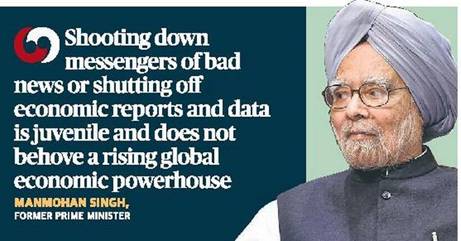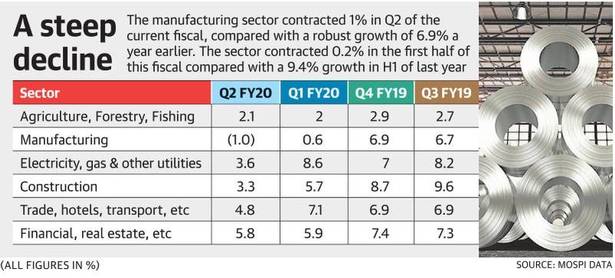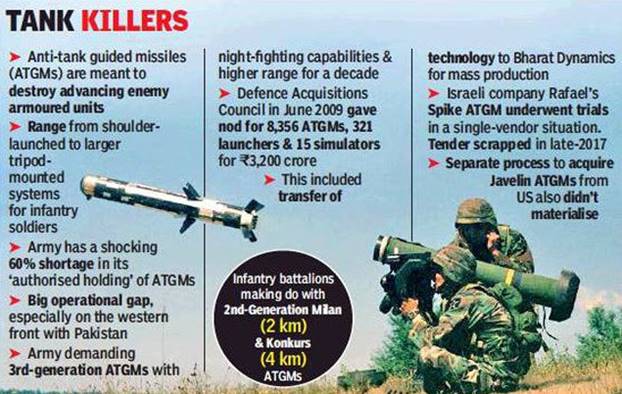DAILY NEWS ANALYSIS 30 NOVEMBER
ECONOMY
Core sector contracts
- The Index of Eight Core Industries contracted in October compared with a contraction of 5.1% in September.
- The coal sector contracted for the fourth consecutive month, by 17.6%, compared with a contraction of 20.5% in September.
- The electricity sector contracted for the third consecutive month, by 12.4% in October.
- Crude Oil sector contracted by 5.1% in October.
- Natural Gas sector contracted by 5.7%,
- Refinery Oil sector expanded by 0.4%.
- Fertilizer sector grew by 11.8%.
- Steel sector contracted by 1.6%
Index of Eight Core Industries (Base: 2011-12=100) August, 2019
- The Eight Core Industries comprise 40.27 per cent of the weight of items included inthe Index of Industrial Production (IIP).

- The IIP data is compiled and published by CSO every month. CSO or Central Statistical Organization operates under the Ministry of Statistics and Programme Implementation (MoSPI).
Reference: https://www.thehindu.com/business/core-sector-contracts/article30118480.ece
Fiscal deficit hits 102% of Budget estimate
The country’s fiscal deficit hit 102.4% of the 2019-20 Budget Estimate (BE) at Rs. 7.2 lakh crores at the end of October.
Other estimates:
- The Centre has estimated the fiscal deficit for the current financial year at Rs. 7.03 lakh crores.
- It was pegged at 3.3% of GDP.
- Government’s revenue receipts during the April-October period of 2019-20 period rose to 46.2 per cent of the BE.
- Capital expenditure stood at 59.5 per cent of the BE during April-October period.
Fiscal deficit represents gap between expenditure and revenue receipts.
‘Economy hit by climate of fear’

Ex Prime Minister Manmohan Singh Comment:
- The figures of GDP growth rate at 4.5% were “completely unacceptable”, and pointed to a “palpable climate of fear”.
- Indian economy is going through a “sharp slowdown”.
- Country should grow at 8-9% for realization of aspirations of people.
- Industrialists are living in the fear of harassments by government authorities.
- Bankers are reluctant to make new loans, for fear of retribution.
- Entrepreneurs are hesitant to put up fresh projects, for fear of failure attributed to ulterior motives.
- Start-ups are living under a shadow of “constant surveillance”.
- Policy makers in government and other institutions are scared to speak the truth or engage in intellectually honest policy discussions.
Reference: https://www.thehindu.com/todays-paper/tp-national/economy-hit-by-climate-of-fear/article30120099.ece
Government needs to recognize real fiscal deficit, put more cash in people’s hands, say economists
The government needs to acknowledge its true fiscal deficit so that it can increase its expenditure and put money in people’s hands in order to stimulate demand and investments in the economy.
Government data:
- GDP grew by 4.5%.
- Private final consumption expenditure (PFCE), a measure of consumption demand, grew 5.06% in Q2.
- Gross fixed capital formation, which measures investments by both the government and the private sector, grew only 1.02%.

Arguments of economists:
- Government need to recognize that there is a real, genuine problem on the demand side.
- It needs to realize there is a problem with people’s incomes, and government need to conduct expenditures that will prop this up.
- The role of putting cash into the economy is relevant, but relevant only for the unorganized sector.
- Unorganized sector has led us out of the past slowdowns.
- Banks need to give loans to unorganized sector for undertaking investment in economy.
INTERNATIONAL
New Delhi announces $450 mn to Colombo
India and Sri Lanka agreed to cooperate on counter-terrorism during talks between Prime Minister Narendra Modi and visiting President Gotabaya Rajapaksa.
Indian announcement:
- India announced a special line of credit of $50 million for strengthening Sri Lanka’s abilities to counter terror threats.
- This was in addition to the $400 million Line of Credit that India announced for infrastructure development in the island nation.
- Both sides want to maintain the Indian Ocean region as a “zone of peace.”
- Sri Lanka will take steps to release the boats of Indian fishermen that are in Sri Lankan custody.
- India has been building housing units in the Northern and Eastern parts of Sri Lanka to assist the people who were displaced during the war of 2009.
Reference: https://www.thehindu.com/todays-paper/india-offers-450-million-to-sri-lanka/article30120167.ece
SECURITY
DRDO defends Nag missile
The state-of-the-art indigenous Anti-Tank Guided Missile (ATGM) Nag is in advanced stages of development, the Defence Research and Development Organization (DRDO).
Anti-tank Missiles:
- Nag is 3rd generation ATGM. It was in the process of being inducted after extensive tests.
- The Man Portable ATGM (MPATGM) was a fourth generation ATGM.
- The Nag missile, the best in its class, was built for Indian conditions.

Reference: https://www.thehindu.com/todays-paper/tp-national/drdo-defends-nag-missiles/article30120078.ece
SOCIETY
Shifting sands in Andhra Pradesh
Scrapping the free sand policy of the previous government, which is said to have boosted the mining mafia, the Jaganmohan Reddy government is attempting to regulate sand mining with a new policy.
New Policy Paradigm:
- It curbs the hoarding, black marketing and illegal mining of sand, and brings down the price of mined sand.
- Under the new system, sand stockyards are managed by the APMDC, and all mining is done by the government.
- The price of sand is now Rs. 370 a ton at government-run stockyards.
- Policy intends to regulate sand extraction and consumption in a scientific manner by prescribing operational guidelines.
Key Guidelines of Policy:
- The APMDC will extract sand on behalf of the government and will comply with environmental regulations while ensuring affordable prices.
- It will also work on raising public revenues to the state exchequer.
- Sand excavation in river streams of I, II, III order will be regulated by the district administration.
- The irrigation department is to take up desiltation of dams, reservoirs, barrages and large lakes directly or through the APMDC.
- The APMDC will put in place an online system for registration of end consumers and transporters.
- Receipt of orders directly from end consumers.
- Collection of payments and remittance to the treasury account of the State government.
- Maintenance of stockyards, disposal of sand from the stockyards, and real-time tracking of sand-carrying vehicles.
Positives of Policy:
- Anyone can book sand through the APMDC website by paying the specified price online or through Meeseva (translated as ‘at your service’) centers.
- Policy ends uncertainty over price and supply to a large extent.
- It brings good payment for sand mining workers.
- Things are running smoothly as far as extraction and supply are concerned.
Concern in Policy:
- There needs to be a scientific study on the availability of sand in different river beds, which will determine the extent to which sand can be mined and the impact of such mining on rivers.
- Current policy violates the Sustainable Sand Mining Management Guidelines of 2016.



1.png)
